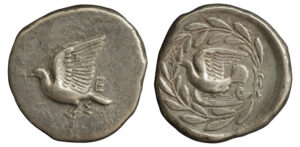Donation by Alexandros Stavridis
On January 4, 2017, a significant donation of 3,056 coins was the first notable acquisition of the Museum for the current year. The donor was Alexandros Stavridis, sole heir of the interesting collection of his late father Dimitrios. His mother Elisabeth had herself taken care of the safety of the deceased’s collection, as a co-heir. Alexandros Stavridis, after the loss of his mother as well, with a deep sense of respect for the memory of his parents, proceeded to hand over their numismatic collection to the Numismatic Museum. Alexandros’ almost permanent settlement in the Netherlands cultivated in him the conviction that the safest, natural place for the collection of Dimitrios Stavridis is the Numismatic Museum. Thus, the study, the promotion and the possible periodic exhibition of these coins now constitute a moral and scientific duty, a pleasant professional duty, a practical recognition of the collector’s contribution to the protection of cultural heritage.
The kind gesture of the offer of Alexandros Stavridis is included in the long list of donors of the Numismatic Museum, as another recent and particularly noteworthy example.
The multitude of Byzantine coins gathered by the collection of Dimitrios Stavridis consists mainly of copper coins and some others of less precious alloys. Late Roman, Roman and especially Greco-Roman coins, issued by provincial mints of the Roman Empire, are impressive as coins of Greek or Greek-speaking regions that maintain the Greek-language tradition, as their inscriptions indicate, and display, among other things, mythological representations or cultic customs. Typical examples are coins from Mithymna on Lesbos, with a minting date during the reign of Geta, from Macedonian Edessa, and from the colony of Antioch in Syria, which are presented below.

1. The copper coin MITHINMNAE, according to its inscription, is particularly rare, having been issued during the reign of the Roman emperor Geta (198-211), son of Septimius Severus. His head is depicted on the obverse of the coin with the relevant inscription, while on the reverse the goddess Tyche is depicted standing, with a rudder and a cornucopia in her hands. The theme is quite common and beloved in the iconography of Greco-Roman as well as Roman coinage, such as on denarii of Septimius Severus. The personification of the goddess Tyche, who dominated the invocations of mortals for good fortune and prosperity, expressed man’s eternal anxiety for tomorrow, especially for the immediate future, which fits perfectly with the war-torn and unstable period of the Severan dynasty.

2. The coin of Edessa, a double “assarium”, was issued during the reign of Septimius Severus with the co-reign of Caracalla (198-211), his firstborn son. On the reverse, it bears the representation of the seated goddess Rome crowned by a standing female figure, the personification of Edessa. The theme, usual and monotonously repeated, almost identical to the mint in question, was inaugurated during the reign of Hadrian, the philhellene emperor who founded the famous Panhellenic. In addition to the city’s respect for Roman power, this iconographic type is also related to the probable inclusion of Edessa in the Panhellenic Empire, as well as to the imperial house’s pursuit of being linked to Alexander the Great. The propaganda, therefore, of the connection of the Roman emperors with the cradle of the Macedonian dynasty is evident in this iconographic theme of Edessa. However, it is a generalized historical confusion of the royal city of Edessa with Aigai, the real birthplace of Alexander’s dynasty, which is also reflected in the written sources of the imperial years.

3. The coin of Antioch, capital of the Roman province of Seleucia Pieria (Syria), during the reign of Trajan Decius (249-251) is an issue of the mint of this Roman colony with a Greek inscription and not a Roman one, as is usually the case in other colonies. The head of Tyche of Antioch, wearing a peplos and crowned with the city walls, depicted on the reverse, is framed by initial Greek letters, Δ-Є, above, and Latin, S-C (S[enatus]- C[onsultum]), below. Above Tyche, a ram runs to the right with its head turned back and there is a star to the lower left of the bust. The Fortune of the city and, in our case, of Antioch, for which a statue of her was sculpted in the early Hellenistic years by Lysippus’ student, Eutychides, was a particularly popular iconographic theme on coins in the prosperous cities of the region, with other variations not uncommon, such as the one with Fortune seated, inside a temple and with the personification of the Orontes River at her feet on coins from the same mint.
The Stavridis collection also includes some ancient Greek coins, expressions of the beauty of ancient Greek art, which stand out as the seal engraving of anonymous artists or some skilled craftsmen created enviable dies intended for coin seals. Two of them are presented here.
4. The silver drachma of Sikyon, from the end of the 5th century BC, is impressive, a rare coin, preserved in good condition. It depicts the same image, a dove with open wings to the left on both sides, with the mint’s initials, S E, respectively behind the bird’s legs and wing, on the obverse and within an olive wreath on the reverse.
5. The silver half-drachm of Elis depicts the head of the Nymph of Olympia on the obverse and the symbol of Zeus, the eagle with closed wings, framed by the initials of the issuing authority, F-׀, on the reverse. The coin dates back to the early Hellenistic period and is related to the coverage of the numerous needs that arose from the Olympic Games and their preparation, the multitude of visitors, the fairs-markets that always accompanied the top sporting event. At the same time, the other rich and elegant silver coins of Elis, mainly staters, drachmas and smaller subdivisions, already from the early classical times, in addition to the costly games, would also cover the costs of ambitious building projects that required high-quality and costly materials.

